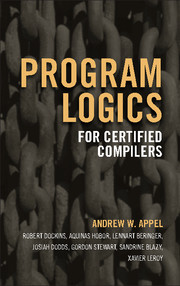Book contents
- Frontmatter
- Dedication
- Contents
- Road map
- Acknowledgments
- 1 Introduction
- I Generic separation logic
- II Higher order separation logic
- III Separation logic for CompCert
- IV Operational semantics of CompCert
- V Higher-order semantic models
- VI Semantic model and soundness of Verifiable C
- 40 Separation algebra for CompCert
- 41 Share models
- 42 Juicy memories
- 43 Modeling the Hoare judgment
- 44 Semantic model of CSL
- 45 Modular structure of the development
- VII Applications
- Bibliography
- Index
44 - Semantic model of CSL
from VI - Semantic model and soundness of Verifiable C
Published online by Cambridge University Press: 05 August 2014
- Frontmatter
- Dedication
- Contents
- Road map
- Acknowledgments
- 1 Introduction
- I Generic separation logic
- II Higher order separation logic
- III Separation logic for CompCert
- IV Operational semantics of CompCert
- V Higher-order semantic models
- VI Semantic model and soundness of Verifiable C
- 40 Separation algebra for CompCert
- 41 Share models
- 42 Juicy memories
- 43 Modeling the Hoare judgment
- 44 Semantic model of CSL
- 45 Modular structure of the development
- VII Applications
- Bibliography
- Index
Summary
Dijkstra presented semaphore-based mutual exclusion as an extension to a sequential language [37]. Posix threads present Dijkstra-Hoare concurrency as an extension to a sequential language [55]. O'Hearn presented concurrent separation logic (CSL) as an extension to separation logic, in which all the rules of sequential separation logic still hold [71].
Can we really model concurrency as an extension to sequentiality? Boehm explains why it is very tricky to explain shared-memory concurrency as an extension to a sequential language [24]. But we have taken great care to specify our language's external-interaction model (Chapter 33), in order to do this soundly.
Therefore we do something ambitious: we present the semantic model of CSL, for the C language, in the presence of an optimizing compiler and weak cache coherency, as a modular extension to our semantic model for sequential separation logic. This chapter is based on Aquinas Hobor's PhD thesis [49, 51] and on current work by Gordon Stewart.
Concurrent separation logic with first-class locks. O'Hearn's presentation of CSL had several limitations, most importantly a lack of first-class locks (locks that can be created/destroyed dynamically, and in particular can be used to control access to other locks). Hobor et al. [51] and Gotsman et al. [44] independently extended CSL to handle first-class locks as well as a number of other features.
Chapter 30 explains our CSL with first-class locks.
- Type
- Chapter
- Information
- Program Logics for Certified Compilers , pp. 401 - 405Publisher: Cambridge University PressPrint publication year: 2014



